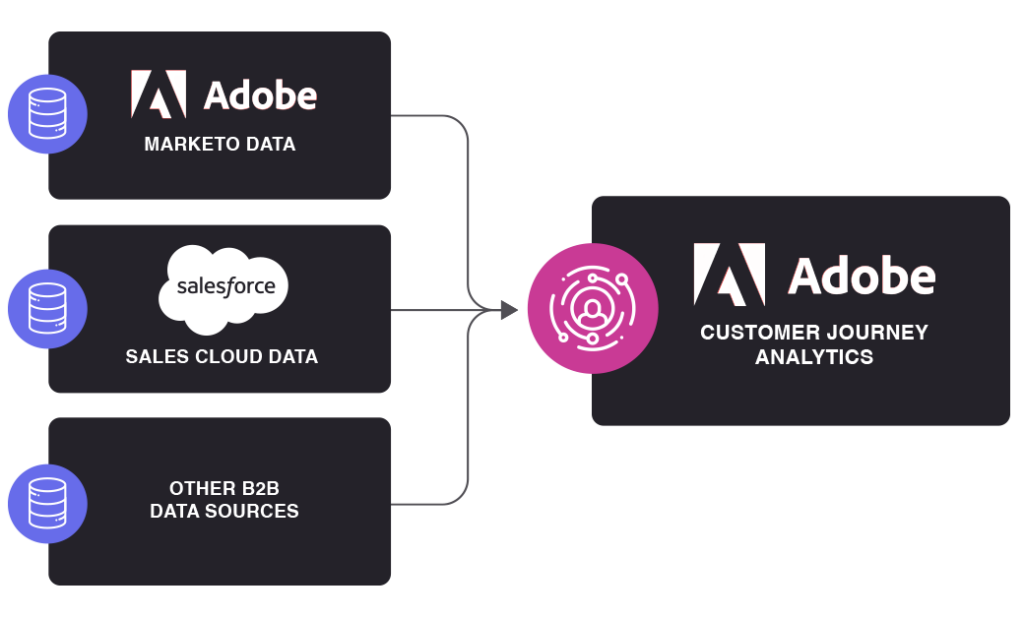Common B2B data sources like Marketo and Salesforce Sales Cloud can easily be joined together with web behavioral data to enable self-service customer journey analysis of the sales funnel, campaign performance, content engagement, lead scoring/qualification, and more.
The business-to-business (B2B) customer journey is rarely a straight line. Instead, it’s a complex dance that involves many touchpoints, stakeholders, and decision-making processes. The typical customer journey takes place over the span of weeks or months.
Modernized analytics platforms like Adobe Customer Journey Analytics can help you overcome B2b data challenges by unifying data for analysis, attributions, and activation.
The data behind this journey is often siloed – web behavioral data is disconnected from campaign data, and even further disconnected from the CRM data that reveals where leads convert to accounts. Attribution often remains a mystery and may become a contentious question. Analysis across these silos ends up causing confusion on metrics and definitions where web behavioral is focused on an individual yet campaign and CRMs focus on accounts.
Modernized analytics platforms like Adobe Customer Journey Analytics (CJA) can help solve these B2B data challenges by unifying data for analysis, attribution, and activation.
The data silo dilemma
Silos form when valuable B2B lead and customer information exists in disparate systems. These data silos prevent teams from gaining a holistic understanding of the end-to-end customer journey.
Your marketing team may have access to deep insights in Marketo, your sales teams may have valuable insights in Salesforce, and your web team may have powerful insights into web behavioral data. But if this data remains fragmented, it can stymie your efforts to answer critical questions that cross data silo boundaries, such as:
- How do marketing campaigns influence pipeline generation and sales conversions?
- What content resonates most with high-value prospects and converted customers?
- Where do potential customers drop off in the full end-to-end journey?
Your ability to answer these types of questions today may rely on a data team specialized in joining data, writing SQL, and outputting data in various formats. This isn’t self-service, it isn’t scalable, it isn’t timely, and it certainly isn’t approachable for your typical marketing or sales team.
In 2024, there are better ways to achieve data unification and self-service for customer journey analysis.
Adobe Customer Journey Analytics: A unifying force
If you’re more familiar with traditional digital analytics platforms like Google Analytics (GA4) and Adobe Analytics, then it’s eye-opening learning about Adobe Customer Journey Analytics and how it can solve your B2B data challenges. It gives you the power to move beyond pageview and web behavioral data to a unified data view across a variety of online and offline touchpoints.
Adobe Customer Journey Analytics lets you bring in virtually any dataset and join it all together. For event datasets, this requires a timestamp and identity field; any data schema is supported.
Common B2B data sources like Marketo and Salesforce Sales Cloud can easily be joined together in Adobe Customer Journey Analytics.
Additionally, lookup datasets can be ingested to further describe and analyze data, such as by adding account-level data to understand buying group behavior. Your journey insights can be segmented and you can drill down to a specific contact or account.
For B2B organizations, common data sources include Marketo and Salesforce Sales Cloud – and these can be joined together in Adobe Customer Journey Analytics.

As a result, teams across your B2B organization gain insight capabilities via a self-service platform, allowing them to understand the following (and more):
- Campaign Performance: Track the effectiveness of marketing campaigns from initial lead generation through to opportunity creation and closed deals. Analyze which campaigns drive the most qualified leads and revenue, allowing for better optimization and resource allocation.
- Content Engagement: Understand how different content types, such as white papers, webinars, and case studies, influence lead behavior and progression through the sales funnel. Identify which content resonates most with specific audiences and personalize your content strategies. Sales teams can quickly identify if a lead has recently engaged by consuming content on the web.
- Lead Scoring & Qualification: Combine Marketo lead scoring data with behavioral data from the web to develop a more comprehensive lead qualification model. This enables sales teams to prioritize high-potential leads and personalize their outreach for greater impact.
- Sales Funnel Optimization: Visualize the entire sales funnel, from lead generation to closed deals, all within Adobe Customer Journey Analytics. Identify bottlenecks, friction, and drop-off points in the journey to optimize the sales process and improve conversion rates.
Adobe Customer Journey Analytics in action: A pratical B2B example
Imagine a scenario in which a B2B software company launches a new product targeted at enterprise clients. By leveraging the combined dataset from web behavior, Marketo, and Salesforce, they can:
- Track the performance of marketing campaigns promoting the new product by identifying which channels and messaging resonate best – all the way through to conversion and becoming a customer.
- Analyze website engagement data to understand how prospects interact with product pages, demos, and more.
- Track the progression of leads through the sales funnel in Salesforce Sales Cloud and correlate it with marketing campaign data and website behavior.
- Identify potential roadblocks in the journey and optimize to improve conversion.
- Measure the overall impact of the product launch on pipeline generation and revenue with a unified view of the customer journey.
Unlocking B2B success through unified customer journey analytics
By breaking down data silos and unifying customer data with Adobe Customer Journey Analytics, B2B organizations can gain a deeper understanding of their leads and customers, optimize marketing campaigns, improve sales effectiveness, and ultimately drive revenue growth.
Improving self-service access to unified customer journey data goes a long way toward operationalizing a data driven culture, breaking through silos, and achieving a competitive advantage.
The use cases discussed here are great starting points to solve pain points and increase usage (and value) of your data. As you gain more experience with Adobe Customer Journey Analytics, you can unlock additional value by expanding out to additional data sets, including but not limited to: support channels, call center, paid marketing channels, product usage analytics, and qualitative voice of customer (VoC).
You’ll quickly find that improving self-service access to unified customer journey data goes a long way toward operationalizing a data driven culture, powering your teams to break through silos and gain a competitive advantage.
As an Adobe Specialized Partner in Adobe Customer Journey Analytics, BlastX Consulting has led transformations with tremendous success. We’d love to help you do the same. Get in touch with us to find out how your teams can evolve with Adobe Customer Journey Analytics.

